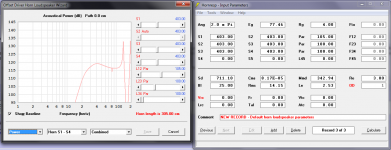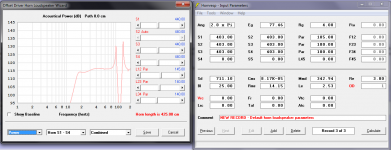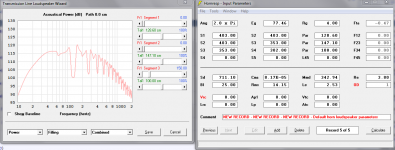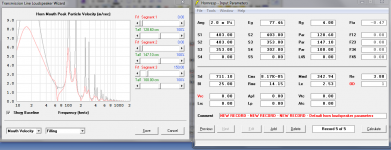I suppose you mean something like the image i have attached? If i am misunderstanding you might need to show me some pictures of your Hornresp. Because i am completely new to it, So sorry if i am getting it wrong. But your design seems to have a 27Hz or so tuning. The goal is flat down to atleast 19Hz. If my normal ported design had a 27Hz tuning the port resonance wouldn't be a problem at all in the first place.Try 400cm2 for 105 cm (offset driver L12) then 100cm in the L23 and L34 segments.
Switch that From ‘Nd’ and ‘OD’ mode in horn and youll see as Nd is not offset (see schematic) .
But if you start with 350-400cm2 at 270-300cm, its easier/funner to learn(explore) from a size thats friendly for TS parameters...
If i make it tune lower it moved the first bad peak down to 100Hz in this TL design. (See second picture) Which is not great. Am i getting something wrong?
Attachments
Yup, you got it, but i didn't know the ‘flat until ....hz part. and i don't stretch too far out of that result unless its my equipment to damage or risk. So anything else is just for fun, and i claim im a dumby, deal?😀
Put that in TH and use
140cm ( or 150/150/100/0.1cm)
140cm
95cm
And 0.1
Then go y
Into wizard section and using ‘filing’ put 200 units of polyfil into the L12 at 100%
Its not flat, but its 22hz or so im guessing(not at compter). But its a long way up to anything rippled or nasty.
If you used 150/150/etc look at driver displacement and consider a MLTL or bass reflex instead.
But also consider raising that 400cm2 slightky at stsrt and dropping (taper) to exit
By a few 100cm2 and watch displscement to be carefulo
Put that in TH and use
140cm ( or 150/150/100/0.1cm)
140cm
95cm
And 0.1
Then go y
Into wizard section and using ‘filing’ put 200 units of polyfil into the L12 at 100%
Its not flat, but its 22hz or so im guessing(not at compter). But its a long way up to anything rippled or nasty.
If you used 150/150/etc look at driver displacement and consider a MLTL or bass reflex instead.
But also consider raising that 400cm2 slightky at stsrt and dropping (taper) to exit
By a few 100cm2 and watch displscement to be carefulo
Last edited:
Sorry, I have no clue where you want me to put those numbers in, You might have to specify. And i think a TH design wants two drivers.Put that in TH and use
140cm ( or 150/150/100/0.1cm)
140cm
95cm
And 0.1
I tapered S3 and S4 until i got a lower tuning and put 150units of filler in segment 3(See Image1), It was interesting to see that the filling in S3 actually lowered the air velocity from 25M/S down to 8 M/S(See Image2). Though i have heard horror stories about putting polyfill in ported enclosures. Where it eventually starts coming unstuck and winds up getting stuck inside the subwoofer, Damaging it.Then go y
Into wizard section and using ‘filing’ put 200 units of polyfil into the L12 at 100%
But also consider raising that 400cm2 slightky at stsrt and dropping (taper) to exit
By a few 100cm2 and watch displscement to be carefulo
I still haven't got a real answer to my original question though. So if anyone knows, Please tell me.
Attachments
How much do i have to worry about port resonance?
FWIW, for my designs, I try to push any resonance effects like that at least one octave above the LP filter point that I intend to use. Others use different "rules of thumb", but this particular one seems to work for me.
So, if you're planning to use a LP filter at 80 Hz, try to push the impact of any resonance effects above 160 Hz.
Thanks for the reply! 160Hz will be impossible with the ultra low tuning. But i guess you are saying it is a real problem. So i will oversize the internal chamber size to at least get the first port resonance above 100Hz. Thanks for the advice! I can finally start finalizing my enclosure design.FWIW, for my designs, I try to push any resonance effects like that at least one octave above the LP filter point that I intend to use. Others use different "rules of thumb", but this particular one seems to work for me.
So, if you're planning to use a LP filter at 80 Hz, try to push the impact of any resonance effects above 160 Hz.
For what's it's worth, my personal experience is that you'll be able to locate a subwoofer with an LPF set to 80Hz - where the driver is facing into the listening position. It's generally known that humans are able to hear where frequencies above 80Hz are coming from. But if setting an a lpf at 80Hz and the driver is firing away from listening position, or behind furniture etc, you might not be able to locate (higher frequencies cant diffract around objects as well as lower frequencies).
Where you set the LPF might also be dependant on what mains you're running though. I have large floorstanders, which I'd argue require 40-60Hz xover. It would take very small mains (small bookshelf maybe) to justify 80Hz LPF.
Where you set the LPF might also be dependant on what mains you're running though. I have large floorstanders, which I'd argue require 40-60Hz xover. It would take very small mains (small bookshelf maybe) to justify 80Hz LPF.
The 80 Hz "standard" is actually based on our inability to clearly localize the sources below 200 Hz. A 12dB(?) octave LP filter at 80 Hz results in the response at 200 Hz being low enough (compared to the main speakers) that it should not possible to localize the subwoofer.
But that's the theory. Practice is another matter. Simple things like having the subwoofer level too high (wrt the main speakers), or the x-over points set incorrectly, or locating the subwoofer where upper bass frequencies are emphasized by room modes, etc. will "break" the theory 🙂.
But that's the theory. Practice is another matter. Simple things like having the subwoofer level too high (wrt the main speakers), or the x-over points set incorrectly, or locating the subwoofer where upper bass frequencies are emphasized by room modes, etc. will "break" the theory 🙂.
Interesting Brian, thanks. My sub is located on the right side of my room with mainly flat bare wall surfaces. The left of my room has a large curtain, sofa, less flat surfaces, generally more absorbing and less reflective. On detailed listening, it bugs me that the sound is slightly weighted towards the right, and could be misinterpreted as incorrectly setup sub.
Last edited:
Interesting thread here. CharlieLaub says that even if you EQ out the port resonance they will still occur due to the movement of air moving in the port.
I planned to do a test as I have a crappy 12" sub from an old project that wouldn't upset me if it blew up but haven't got round to it yet.
Cheers,
Rob.
I planned to do a test as I have a crappy 12" sub from an old project that wouldn't upset me if it blew up but haven't got round to it yet.
Cheers,
Rob.
Thanks for showing me that! So the main driver playing near the first port resonance can generate it, Other speakers playing around it can trigger it and also port turbulence can generate port resonance ringing. Which would happen most from playing around the tuning frequencies. Which are 23.5Hz with three ports open, 19Hz with two ports open and 13.5Hz with one.Interesting thread here. CharlieLaub says that even if you EQ out the port resonance they will still occur due to the movement of air moving in the port.
I planned to do a test as I have a crappy 12" sub from an old project that wouldn't upset me if it blew up but haven't got round to it yet.
Cheers,
Rob.
Although the manual for BassBox Pro suggest that this is a bigger problem with Bandpass boxes than normal ported bass reflex enclosures.
"Vent resonance is usually not a problem for standard vented boxes for several reasons. The drivers function as direct radiators and the system acts as a high-pass filter allowing the upper frequency response of the driver to mask the resonance peaks of a vent. However, bandpass boxes produce all of their sound through vents and the upper frequency roll-off of bandpass systems can expose their larger vent resonance peaks." -BassBox Pro
Though once again, This doesn't really give any super clear answers.
Some real world testing on normal ported enclosures would be great! To really find where the limit is. The closest i have is my online friend who has a 18" Dayton Ultimax sub in a ported enclosure tuned to 17Hz with a first port resonance of 120Hz. He tested playing frequencies around tuning (15Hz-17Hz) at high volume to cause turbulence and never has heard any 120Hz ringing. Though he did hear some weirdness when he raised his LPF and played around 120Hz. But it wasn't a problem for him with any normal listening. But a 87Hz resonance is a whole lot lower, So it is hard to judge what the real world result would be.
Thanks for showing me that! So the main driver playing near the first port resonance can generate it, Other speakers playing around it can trigger it and also port turbulence can generate port resonance ringing.
I suspect that's a theoretical construct that practically does not result in any audible and perhaps even measurable difference.
- Home
- Loudspeakers
- Subwoofers
- First Port Resonance Too Low?



